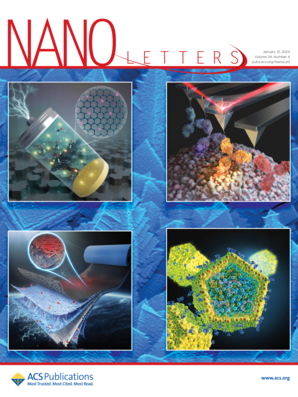Emissive Traps Lead to Asymmetric Photoluminescence Line Shape in Spheroidal CsPbBr3 Quantum Dots
IF 9.6
1区 材料科学
Q1 CHEMISTRY, MULTIDISCIPLINARY
引用次数: 0
Abstract
The morphology of quantum dots plays an important role in governing their photophysics. Here, we explore the photoluminescence of spheroidal CsPbBr3 quantum dots synthesized via the room-temperature trioctylphosphine oxide/PbBr2 method. Despite photoluminescence quantum yields nearing 100%, these spheroidal quantum dots exhibit an elongated red photoluminescence tail not observed in typical cubic quantum dots synthesized via hot injection. We explore the origins of this elongated red tail through structural and optical characterization including small-angle X-ray scattering, transmission electron microscopy and time-resolved, steady-state, and single quantum dot photoluminescence. From these measurements we conclude that the red tail originates from emissive traps. We show that treating spheroidal quantum dots with phenethylammonium bromide decreases the line shape asymmetry and increases passivation–consistent with emissive traps due to polar facets.

求助全文
约1分钟内获得全文
求助全文
来源期刊

Nano Letters
工程技术-材料科学:综合
CiteScore
16.80
自引率
2.80%
发文量
1182
审稿时长
1.4 months
期刊介绍:
Nano Letters serves as a dynamic platform for promptly disseminating original results in fundamental, applied, and emerging research across all facets of nanoscience and nanotechnology. A pivotal criterion for inclusion within Nano Letters is the convergence of at least two different areas or disciplines, ensuring a rich interdisciplinary scope. The journal is dedicated to fostering exploration in diverse areas, including:
- Experimental and theoretical findings on physical, chemical, and biological phenomena at the nanoscale
- Synthesis, characterization, and processing of organic, inorganic, polymer, and hybrid nanomaterials through physical, chemical, and biological methodologies
- Modeling and simulation of synthetic, assembly, and interaction processes
- Realization of integrated nanostructures and nano-engineered devices exhibiting advanced performance
- Applications of nanoscale materials in living and environmental systems
Nano Letters is committed to advancing and showcasing groundbreaking research that intersects various domains, fostering innovation and collaboration in the ever-evolving field of nanoscience and nanotechnology.
 求助内容:
求助内容: 应助结果提醒方式:
应助结果提醒方式:


